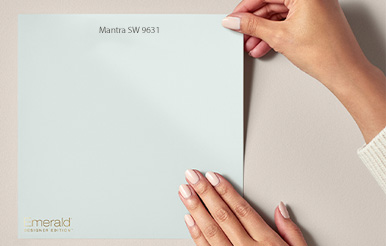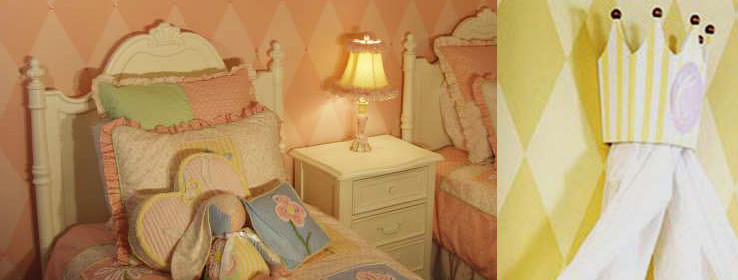Learn how to give a blank wall some personality with a diamond pattern. Diamond patterns are a great decorative painting technique for your walls. Read the steps below on how to paint diamond patterns to your wall.
Watch the Video on How to Paint Diamonds
- Two different paint colors €“ Basecoat and coordinating color for diamond pattern
- 1" or 2" low-tack/safe-release tape
- 9" roller frame and cover
- Mini roller frame and cover
- Roller pan with liner
- Pencil, colored pencil or chalk to mark lines
- Tape measure, carpenters level, straight edge
Step 1:
Figure out the size your diamond pattern is going to be. A rule of thumb is that the height of the diamond should be twice the width.
Tip: If you want a full diamonds across the wall as seen in this illustration, first measure the width of your wall. Divide by the number of diamonds you want horizontally. In this case it is 4. Use that measurement as the width of the diamond and multiply by 2 for the height. Depending on the size of your walls you may need to adjust the height of the diamond to create the pattern you see in this illustration. Once you have figured out how big your diamond will be you can move on to step 2.
Step 2:
When you have all your supplies ready, and the room cleared for painting, paint your base coat of paint on the wall with the lighter of the two colors you have decided to use. Let it dry at least 4 hours or overnight for best results.
Step 3:
Once you have calculated the width and height of your diamonds it is time to draw your lines vertically down the wall where your diamonds will be. Measure the width of the diamond using your level. Draw a straight line the exact width of the diamond all the way down the wall/area vertically. Keep going across the wall/area until all vertical lines are drawn. Start with the wall/area you see as you enter the room. After you finish that wall/area, draw your lines on either side starting from the ends of the wall/area you just completed. Some adjustments may be necessary once you reach the ends of the other walls/area. You can adjust the width of the diamonds slightly, but never adjust the height. Draw horizontal lines the height of your diamond the entire length of the wall/area. You will now have a grid pattern on the wall/area you are painting.
Step 4:
Find the middle of each rectangle and mark the top, bottom, right and left side. Then connect the dots by drawing lines to form your diamond pattern. Keep in mind that all these lines will have to be erased at some point, so you may not want to make too dark a line with your pencil. Chalk, however will wipe off more easily. It is possible to connect the dots with tape without drawing lines. If you do not feel confident, DRAW THE LINES that will form your diamond. Don't attempt to tape all the way down your wall in one line as it is difficult to keep the tape straight enough on the wall/area without a partner. Rather, tear off a piece of tape just long enough to cover each side of your diamond.
Step 5:
Using the mini roller, paint to fill in the diamond patterns. Let the paint dry. Remove tape and check for any areas that need touching up.
Video Transcription:
Let your walls be the star of the room with diamonds.
Be bold or whimsical with two contrasting hues, or subtle and elegant with two light colors.
Either way, diamonds add an enticing visual interest to any wall or ceiling.
In this video, we'll show you how to make a diamond pattern on a wall.
Step 1: Preparation.
Think about the design you'd like to create.
How many colors do you want to use?
Do you prefer large or small diamonds?
Will you use two different Sheens?
No matter what size diamonds you choose, the height of the diamond should be twice the width.
To help determine the best diamond size for your space, measure the height and width of your wall.
For example, if your wall is 96 inches high and 72 inches wide, 4 or 8 inches would be a good height for a small diamond.
If you want a larger diamond, 16 or 24 inches would be a good height.
Keep in mind, if you choose numbers that divide evenly with the height and width of your wall, the diamond pattern will fit your wall.
Gather the right tools for your project at your neighborhood Sherwin-Williams store.
Choose your paint colors.
One color is the base coat and the others are coordinating colors which create the diamond pattern.
Make sure you have the following supplies: one or two inch low tack safe-release tape, a nine inch roller frame and cover, mini roller frame and cover, two to three inch paintbrush, roller pan with liner, tape measure, carpenter's level, straightedge, and a pencil.
Step 2: Paint the base coat.
You can use your existing wall color as the base coat or apply a new color.
If you apply a new color, let it dry for at least four hours or overnight for best results.
Step 3: Create the diamond pattern.
Start by drawing a grid of vertical and horizontal lines on each wall.
The distance between the vertical lines is half the width of the diamond.
From the edge of each wall, mark the vertical lines across the wall.
If you're using a chalk line, use blue chalk because red and yellow are permanent.
Mark the horizontal lines down the wall.
The distance between your horizontal lines is half the height of the diamond.
Now your wall should look like a rectangle grid.
To create the diamond pattern, draw a diagonal line through the corner of each rectangle, alternating directions.
Step 4: Apply tape and paint.
Determine which diamonds you want to paint the coordinating color and firmly apply tape on the outside of every other one.
Use a brush or mini roller to apply the coordinating color in each diamond.
Let the paint dry for at least 4 hours.
Then remove the tape by angling it away from the painted diamonds.
Now apply tape around the remaining diamonds, paint them and when dry, remove the tape.
Clean or touch-up any pencil marks and you're done.
Creating original art on your walls is easy with Sherwin-Williams.
Whether your diamonds are large or small, you'll love how they make your room sparkle.
For more information about other decorative techniques or Sherwin-Williams, visit sherwin-williams.com.










